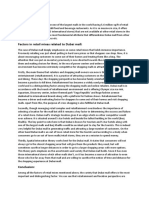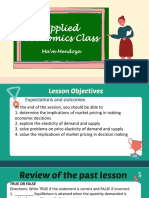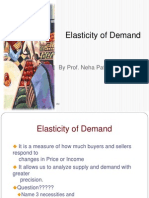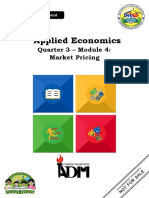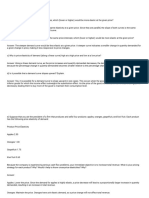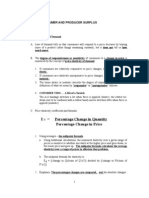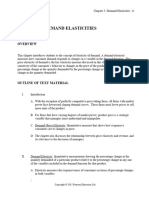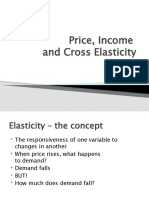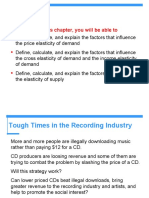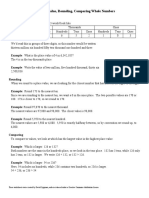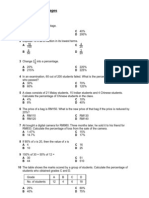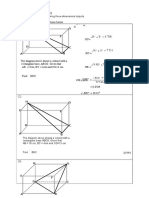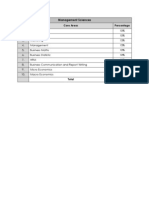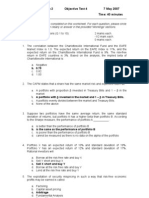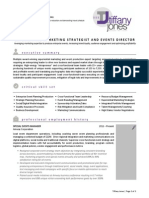0 ratings0% found this document useful (0 votes)
1K viewsExercise 2.3 Price Elasticity
Exercise 2.3 Price Elasticity
Uploaded by
Karmen ThumThis document provides examples and explanations of price elasticity of demand (PED) and price elasticity of supply. It asks the reader to determine if examples of goods are elastic, inelastic, or unit elastic based on the percentage change in quantity demanded or supplied given a percentage change in price. It also asks the reader to determine if total revenue would rise, fall, or stay the same based on whether demand is elastic, inelastic, or unit elastic. Finally, it provides an example of calculating PED based on price and quantity data and determining if demand is elastic, inelastic, or unit elastic in that price range.
Copyright:
© All Rights Reserved
Available Formats
Download as DOCX, PDF, TXT or read online from Scribd
Exercise 2.3 Price Elasticity
Exercise 2.3 Price Elasticity
Uploaded by
Karmen Thum0 ratings0% found this document useful (0 votes)
1K views2 pagesThis document provides examples and explanations of price elasticity of demand (PED) and price elasticity of supply. It asks the reader to determine if examples of goods are elastic, inelastic, or unit elastic based on the percentage change in quantity demanded or supplied given a percentage change in price. It also asks the reader to determine if total revenue would rise, fall, or stay the same based on whether demand is elastic, inelastic, or unit elastic. Finally, it provides an example of calculating PED based on price and quantity data and determining if demand is elastic, inelastic, or unit elastic in that price range.
Original Description:
Economics
Copyright
© © All Rights Reserved
Available Formats
DOCX, PDF, TXT or read online from Scribd
Share this document
Did you find this document useful?
Is this content inappropriate?
This document provides examples and explanations of price elasticity of demand (PED) and price elasticity of supply. It asks the reader to determine if examples of goods are elastic, inelastic, or unit elastic based on the percentage change in quantity demanded or supplied given a percentage change in price. It also asks the reader to determine if total revenue would rise, fall, or stay the same based on whether demand is elastic, inelastic, or unit elastic. Finally, it provides an example of calculating PED based on price and quantity data and determining if demand is elastic, inelastic, or unit elastic in that price range.
Copyright:
© All Rights Reserved
Available Formats
Download as DOCX, PDF, TXT or read online from Scribd
Download as docx, pdf, or txt
0 ratings0% found this document useful (0 votes)
1K views2 pagesExercise 2.3 Price Elasticity
Exercise 2.3 Price Elasticity
Uploaded by
Karmen ThumThis document provides examples and explanations of price elasticity of demand (PED) and price elasticity of supply. It asks the reader to determine if examples of goods are elastic, inelastic, or unit elastic based on the percentage change in quantity demanded or supplied given a percentage change in price. It also asks the reader to determine if total revenue would rise, fall, or stay the same based on whether demand is elastic, inelastic, or unit elastic. Finally, it provides an example of calculating PED based on price and quantity data and determining if demand is elastic, inelastic, or unit elastic in that price range.
Copyright:
© All Rights Reserved
Available Formats
Download as DOCX, PDF, TXT or read online from Scribd
Download as docx, pdf, or txt
You are on page 1of 2
Exercise 2.
3 (PED and price elasticity of supply)
1. Suppose the price of paper rises 10% and the quantity demanded falls 15%.
a. Is the price elasticity of demand for paper elastic, unit elastic, or inelastic?
b. Will revenue rise, decline, or stay the same with the given change in price?
2. Suppose the price of a can of green beans rises 6 percent and the quantity supplied rises 3
percent. Is the price elasticity of supply elastic, unit elastic, or inelastic?
3. For each of the following items assume the price elasticity of demand is as indicated.
Determine whether the good or service is elastic, unit elastic, or inelastic.
Also determine what would happen to the total revenue for the sellers of the items given the
indicated price change?
a. Medical care. PED = 0.1. Price rises.
b. Cars. PED = 1.2. Price falls.
c. Wheat. PED = 1.8. Price rises.
d. Cigarettes. PED = 0.7. Price falls.
e. Carpet cleaning. PED = 1. Price rises.
4. Suppose the price of almonds rises from $4.35 to $5.15 per pound and the quantity demanded
falls from 800 to 735 kilograms.
a. What is the price elasticity of demand for almonds in this price range?
b. Are almonds elastic, unitary elastic, or inelastic in this price range?
c. What is the interpretation of that price elasticity of demand-what does it mean?
Answer Exercise 2.3 (PED and price elasticity of supply)
1. Price elasticity of demand is the percent change in quantity demanded divided by the percent
change in price. Demand is elastic if the price elasticity is greater than one (always drop the
negative sign-take the absolute value); a rise in price will lower total revenue. Demand is
inelastic if the price elasticity is less than one; a rise in price will increase total revenue. Demand
is unit elastic if the price elasticity is equal to one; a rise in price leaves total revenue unchanged.
a. rice elasticity of demand is 15%/10% = 1.5. Since 1.5 > 1, demand is elastic.
b. Total revenue falls. This is because the percent decrease in the quantity demanded (15%)
exceeds the percent increase in the price (10%)
2. Price elasticity of supply is 3%/6% = 0.5. Since 0.5 < 1, supply is inelastic. Recall, price
elasticity of supply is defined in your text as the percent change in quantity supplied divided by
the percent change in price. Supply is elastic if the price elasticity is greater than one. Supply is
inelastic if the price elasticity is less than one. Supply is unit elastic if the price elasticity is equal
to one.
3a. Inelastic, because the coefficient (number) is less than one. Total revenue would rise.
3b. Elastic, because the coefficient is greater than one. Total revenue would rise.
3c. Elastic, because the coefficient is greater than one. Total revenue would fall.
3d. Inelastic, because the coefficient is less than one. Total revenue would fall.
3e. Unitary elastic, because the coefficient is equal to one. Total revenue would remain
unchanged (the percentage increase in the price is just offset by a proportional percentage
decrease in the quantity demanded).
4a. PED = (735-800) / 800
(5.15-4.35) / 4.35
= 0.4418
(remember to drop the negative sign).
4b. Consumers have an inelastic demand for almonds in this price range because the absolute
value of the elasticity of demand coefficient is less than one.
4c. Price inelasticity means consumers are relatively unresponsive to a price change.
You might also like
- Simulation: Phone VenturesDocument22 pagesSimulation: Phone VenturesFaiza Rasheed67% (3)
- Elasticity Cheat SheetDocument4 pagesElasticity Cheat Sheetnreid2701100% (2)
- Economics for CFA 2024: level 1 in just one week: CFA level 1, #4From EverandEconomics for CFA 2024: level 1 in just one week: CFA level 1, #4Rating: 4.5 out of 5 stars4.5/5 (2)
- A level Economics Revision: Cheeky Revision ShortcutsFrom EverandA level Economics Revision: Cheeky Revision ShortcutsRating: 3 out of 5 stars3/5 (1)
- Dubai Mall CaseDocument2 pagesDubai Mall CaseAjia AfaqueNo ratings yet
- Product Bundle Pricing: Price Process PeopleDocument8 pagesProduct Bundle Pricing: Price Process PeopleHương LýNo ratings yet
- Retail Strategic Growth Plan For Showpo - Business ReportDocument3 pagesRetail Strategic Growth Plan For Showpo - Business Reportapi-3262257420% (1)
- Price Elasticity Week 5Document38 pagesPrice Elasticity Week 5Katrina LabisNo ratings yet
- Chap 2 Elasticity and Its Application Part 3Document48 pagesChap 2 Elasticity and Its Application Part 3The TwitterNo ratings yet
- Multiple Choice Tutorial: Elasticity of Demand & SupplyDocument63 pagesMultiple Choice Tutorial: Elasticity of Demand & SupplyZURMAN1No ratings yet
- Assignment 1 MIDTERMDocument1 pageAssignment 1 MIDTERMRye FelimonNo ratings yet
- Elasticity of DemandDocument22 pagesElasticity of DemandHeta ShastriNo ratings yet
- 18e Key Question Answers CH 6Document3 pages18e Key Question Answers CH 6aliabuelNo ratings yet
- Price ElasticityDocument18 pagesPrice ElasticityElle MNOP.No ratings yet
- AppliedEconomics - Q3 - Mod4 - Market PricingDocument15 pagesAppliedEconomics - Q3 - Mod4 - Market Pricingrebecca tanaidNo ratings yet
- Ecf100 FPD 16 2018 1Document3 pagesEcf100 FPD 16 2018 1Emmanuel MwangalaNo ratings yet
- Chapter 5 N 6 Questions For ReviewDocument3 pagesChapter 5 N 6 Questions For ReviewNguyễn Thị ThờiNo ratings yet
- Chapter 05 QuestionsDocument20 pagesChapter 05 QuestionsArigato BanzayNo ratings yet
- 5jOslNKvBhDocument3 pages5jOslNKvBhZainullah KhanNo ratings yet
- Tutorial 3 - AnswersDocument3 pagesTutorial 3 - AnswersChoon Pin ChongNo ratings yet
- MICRO SG 9e Chap 05Document20 pagesMICRO SG 9e Chap 05Asif Ali100% (1)
- Economics 1Document4 pagesEconomics 1Meshu QadirNo ratings yet
- Chapter Six Elasticity, Consumer and Producer Surplus: Percentage Change in Quantity Percentage Change in PriceDocument7 pagesChapter Six Elasticity, Consumer and Producer Surplus: Percentage Change in Quantity Percentage Change in Pricepakibroz5No ratings yet
- Economics For Managers - Notes-2Document15 pagesEconomics For Managers - Notes-2Phillip Gordon MulesNo ratings yet
- Chapter Twenty: Elasticity of Demand and SupplyDocument5 pagesChapter Twenty: Elasticity of Demand and SupplyMya BallinNo ratings yet
- Document From Hassan RazaDocument14 pagesDocument From Hassan RazaAli RazaNo ratings yet
- Notes: Grade 12: Price Elasticity of Demand (PED) Measures How Responsive Is The Quantity Demanded of OneDocument11 pagesNotes: Grade 12: Price Elasticity of Demand (PED) Measures How Responsive Is The Quantity Demanded of Oneshamz17No ratings yet
- Class Note: Price Elasticity and Change in RevenueDocument13 pagesClass Note: Price Elasticity and Change in RevenueFatikchhari USONo ratings yet
- Elasticity PP TDocument42 pagesElasticity PP TMayurRawoolNo ratings yet
- Practice Questions 2 For Mid - Term ExamDocument3 pagesPractice Questions 2 For Mid - Term ExamMukhrizIzrafAzmanAzizNo ratings yet
- Elasticity of Demand: Perfect Elasticity or Infinite ElasticityDocument10 pagesElasticity of Demand: Perfect Elasticity or Infinite ElasticitySeakh Mohammad ShihabNo ratings yet
- Chapter 4 AnswersDocument4 pagesChapter 4 AnswersMahekParmarNo ratings yet
- ElasticityDocument51 pagesElasticitySumedha SunayaNo ratings yet
- Price Elasticity of Demand ExercisesDocument3 pagesPrice Elasticity of Demand Exercisesfatimazahraatmani180No ratings yet
- Elasticity of Demand and SupplyDocument9 pagesElasticity of Demand and SupplyAlex HongoNo ratings yet
- Microeconomics Chapter 3 1Document14 pagesMicroeconomics Chapter 3 1Eury KaneNo ratings yet
- Ch03 ElasticityDocument6 pagesCh03 Elasticitycarlhoorn91No ratings yet
- Macroeconomics Unit 2 Test FRQDocument3 pagesMacroeconomics Unit 2 Test FRQsohamNo ratings yet
- Elasticity of Supply and Demand SessionDocument23 pagesElasticity of Supply and Demand SessionCharlizeK0% (1)
- Microeconomics Chapter 3Document14 pagesMicroeconomics Chapter 3Ian Jowmariell GonzalesNo ratings yet
- Elasticity and Its ApplicationsDocument44 pagesElasticity and Its ApplicationsFahadNo ratings yet
- Elasticity of Demand Class JLD LSK LDK Ask DK Asd As DK Las Dkas KLD As DK Ask Ldkals KDL SKL Dkal SK LDDocument24 pagesElasticity of Demand Class JLD LSK LDK Ask DK Asd As DK Las Dkas KLD As DK Ask Ldkals KDL SKL Dkal SK LDVikas RockNo ratings yet
- Price, Income and Cross ElasticityDocument47 pagesPrice, Income and Cross ElasticityFaizan QudsiNo ratings yet
- Price, Income and Cross ElasticityDocument47 pagesPrice, Income and Cross ElasticityFaizan QudsiNo ratings yet
- Managerial Economics Topic 3 Elasticity of DemandDocument65 pagesManagerial Economics Topic 3 Elasticity of Demandyaminis.0223No ratings yet
- Chap 04Document16 pagesChap 04Syed Hamdan100% (1)
- Managerial Economics Topic 5Document65 pagesManagerial Economics Topic 5Anish Kumar Singh0% (1)
- Applied Economics - 1st-QRTR - PPT - 5Document63 pagesApplied Economics - 1st-QRTR - PPT - 5Agnes RamoNo ratings yet
- 02Document16 pages02Paran GuptaNo ratings yet
- ME Session 6 7Document31 pagesME Session 6 7vaibhav khandelwalNo ratings yet
- Be Tutorial 3 - StuDocument18 pagesBe Tutorial 3 - StuGia LinhNo ratings yet
- Tute 03 - Demand Supply ManagementDocument21 pagesTute 03 - Demand Supply ManagementNivneth PeirisNo ratings yet
- Assignment 1 ECO 550Document11 pagesAssignment 1 ECO 550eprinceotis_10363054100% (1)
- Elasticity 1Document28 pagesElasticity 1Samiur RahmanNo ratings yet
- Objectives: After Studying This Chapter, You Will Be Able ToDocument50 pagesObjectives: After Studying This Chapter, You Will Be Able ToPavan KumarNo ratings yet
- Be 313 - Unit Learning CDocument19 pagesBe 313 - Unit Learning Cmhel cabigonNo ratings yet
- Worked Problems Price Elasticity of DemandDocument3 pagesWorked Problems Price Elasticity of DemandAdiNo ratings yet
- Principles of Macroeconomics 7th Edition Gregory Mankiw Solutions Manual 1Document36 pagesPrinciples of Macroeconomics 7th Edition Gregory Mankiw Solutions Manual 1cynthiasheltondegsypokmj100% (36)
- Sales Plan: Price Elasticity, Cross Elasticity & Income ElasticityDocument7 pagesSales Plan: Price Elasticity, Cross Elasticity & Income Elasticityrajibbarua2009No ratings yet
- F-Price Ealsticity of Demand and Supply Dr. ManalDocument42 pagesF-Price Ealsticity of Demand and Supply Dr. ManalabuazzoumNo ratings yet
- 03 - MG - Microeconomics IDocument16 pages03 - MG - Microeconomics Iazirasulova97No ratings yet
- Elasticity of Demand WorksheetDocument3 pagesElasticity of Demand WorksheetVijay KumarNo ratings yet
- 02Document8 pages02Anubhav JainNo ratings yet
- PT3 Polygons PDFDocument6 pagesPT3 Polygons PDFKarmen ThumNo ratings yet
- Obedience KeysDocument5 pagesObedience KeysKarmen ThumNo ratings yet
- F1 MathsDocument84 pagesF1 MathsKarmen ThumNo ratings yet
- Kertas 2Document14 pagesKertas 2Jacie KoeNo ratings yet
- Form 1 - Chapter 3Document8 pagesForm 1 - Chapter 3Nor Kamsiah Kamarul Jaeh100% (2)
- Maths Form 1 Chapter 5Document3 pagesMaths Form 1 Chapter 5Nurkamalia Kamilan75% (4)
- f5 Am c1 Geometric ProgressionDocument14 pagesf5 Am c1 Geometric ProgressionKarmen ThumNo ratings yet
- f5 Am c1 ProgressionDocument9 pagesf5 Am c1 ProgressionKarmen ThumNo ratings yet
- Revision AM Log Progression Linear LawDocument4 pagesRevision AM Log Progression Linear LawKarmen ThumNo ratings yet
- F5 C6 Permutation and CombinationDocument4 pagesF5 C6 Permutation and CombinationKarmen ThumNo ratings yet
- Solution of Triangles 3.2 Task: Answer All The Questions Below.Document23 pagesSolution of Triangles 3.2 Task: Answer All The Questions Below.Karmen ThumNo ratings yet
- f4 c11 Index NumberDocument12 pagesf4 c11 Index NumberKarmen ThumNo ratings yet
- Managerial Economics: David Besanko, Ronald Braeutigam: MicroeconomicsDocument8 pagesManagerial Economics: David Besanko, Ronald Braeutigam: MicroeconomicsMoidin AfsanNo ratings yet
- Nano Mba Capsule PDFDocument48 pagesNano Mba Capsule PDFsatyajitNo ratings yet
- DemandDocument13 pagesDemandthayumanavarkannan100% (1)
- Document On Berger Paints SlideDocument48 pagesDocument On Berger Paints SlideSammy BossNo ratings yet
- Fair Value Gaps - TTrades - EduDocument9 pagesFair Value Gaps - TTrades - EduFelipe Castañeda100% (2)
- GAT Subject SyllabusDocument5 pagesGAT Subject SyllabusAliNo ratings yet
- IB Economics Microeconomics Unit Exemplar IADocument8 pagesIB Economics Microeconomics Unit Exemplar IAcorlisschan12030% (1)
- 1 - The Investment SettingDocument48 pages1 - The Investment SettingYash Raj SinghNo ratings yet
- Diverse Populations, Genders, Skin Types and Ethnic SpecificitiesDocument10 pagesDiverse Populations, Genders, Skin Types and Ethnic SpecificitiesAsif AliNo ratings yet
- Fruity Graham Mission and VisionDocument2 pagesFruity Graham Mission and VisionJohn Danielle Cerdan100% (2)
- Chapter 10 Notes Principles of MicroeconomicsDocument2 pagesChapter 10 Notes Principles of MicroeconomicsDerek Ng100% (2)
- The Marketing Plan: Hisrich Peters ShepherdDocument22 pagesThe Marketing Plan: Hisrich Peters ShepherdGul AfshanNo ratings yet
- TeamIgniteers - BYTECRUNCH 2022Document4 pagesTeamIgniteers - BYTECRUNCH 2022Mayank KaleNo ratings yet
- Week 2 AssignmentDocument4 pagesWeek 2 AssignmentArunim YadavNo ratings yet
- The Equilibrium of Supply and Demand: Grafik 1Document6 pagesThe Equilibrium of Supply and Demand: Grafik 1M RezzaNo ratings yet
- Developing Marketing Strategies and Plans: Marketing Management - I PGDM - Term I - 2021 Sdmimd IndiaDocument20 pagesDeveloping Marketing Strategies and Plans: Marketing Management - I PGDM - Term I - 2021 Sdmimd IndiaRishikesh DargudeNo ratings yet
- Currency Derivatives: For Use With International Financial Management, 3e Jeff Madura and RolandDocument37 pagesCurrency Derivatives: For Use With International Financial Management, 3e Jeff Madura and Rolandياسين البيرنسNo ratings yet
- Something About EquilibriumsDocument4 pagesSomething About EquilibriumsJoble02No ratings yet
- Book Building ProcessDocument4 pagesBook Building Processvarsh08No ratings yet
- Intermediate Accounting CH 6 SolutionsDocument6 pagesIntermediate Accounting CH 6 SolutionsNatazia IbañezNo ratings yet
- XI Commerce Notes CH 1Document5 pagesXI Commerce Notes CH 1Lalit NathNo ratings yet
- Eighteenth Edition: Pricing Strategies: Additional ConsiderationsDocument39 pagesEighteenth Edition: Pricing Strategies: Additional ConsiderationsYen YiNo ratings yet
- Bus3026w Obj4Document5 pagesBus3026w Obj4api-3708231No ratings yet
- Course Handout MPBA G501Document4 pagesCourse Handout MPBA G501maanuNo ratings yet
- ChocolateDocument6 pagesChocolateNupur BhatiaNo ratings yet
- Experiential Marketing Events Director in Orange County CA Resume Tiffany JonesDocument3 pagesExperiential Marketing Events Director in Orange County CA Resume Tiffany JonesTiffanyJones1100% (1)




